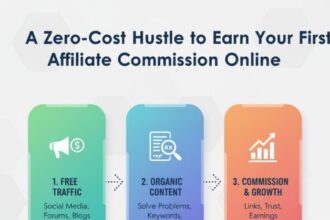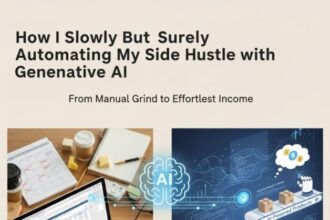I Thought SEO Was Black Magic. Turns Out, It’s Just Being Helpful.
The silence was deafening.
I had just spent an entire weekend writing what I thought was the most brilliant blog post of my life. It was witty, it was well-researched, it was, in my humble opinion, a masterpiece.
I hit “publish,” full of that giddy, hopeful feeling. This is it, I thought. This is the one that goes viral.
And then… nothing. A week went by. My traffic stats showed a flat line. A few visits from my mom, probably. A few from my most loyal friends. But from the rest of the world? Crickets.
It felt like I had thrown the world’s greatest party, sent out hundreds of beautifully written invitations, and then sat alone in an empty room, listening to the clock tick.
I was heartbroken. And confused. Why wasn’t anyone finding my work?
That night, my sad, desperate Google search was simple: How to raise your rankings in search engines. I didn’t even really know what that meant. I just knew that I was creating content that I was proud of, and it was invisible.
This isn’t a guide from an SEO guru with a secret formula. I’m just a regular person who was tired of shouting into the void. This is the messy, often frustrating story of how I stumbled my way through the confusing world of SEO and discovered that it’s not nearly as scary, or as complicated, as I thought.
My First Clumsy Steps into the World of SEO
My initial dive into the world of SEO was, to put it mildly, terrifying.
I felt like I had just discovered a secret, powerful society that had its own language, its own rules, and its own weird rituals.
It was a world of acronyms. SEO, SERP, DA, PA, CTR. My brain was swimming in alphabet soup. I’d read one article, and it would talk about “backlinks” and “domain authority.” I’d watch a YouTube video, and it would be all about “keyword density” and “meta descriptions.”
I felt so, so stupid. It seemed like everyone else understood this secret language, and I was on the outside looking in. I was trying to learn the basic SEO for bloggers, but it felt like I was trying to learn quantum physics.
The “Keyword Stuffing” Disaster
My first real attempt at “doing SEO” was a complete and utter mess. I had read somewhere that you needed to use your “keyword” a lot in your article. So, for my next blog post, I decided my keyword was “best indoor plants.
And I went to town.
The article was a train wreck. “If you are looking for the best indoor plants, you have come to the right place. The best indoor plants are easy to care for. Here are some of the best indoor plants you can buy…”
It sounded like it was written by a robot. A very stupid robot.
I thought I was being so clever. I was “optimizing” my content. I was speaking Google’s language.
I hit publish, feeling very proud of myself.
And the article went nowhere. It didn’t rank. No one read it. Because it was unreadable. It was a spammy, clunky, keyword-stuffed mess. I had been so focused on pleasing the search engine that I had forgotten to please the actual human being who was supposed to read the article.
The Overwhelming World of “Keyword Research”
After the keyword stuffing fiasco, I realized I needed to be smarter. I learned that I couldn’t just guess my keywords; I had to do “research.” So I fell down the next rabbit hole: keyword research for beginners.
This was even more confusing. There were all these expensive, intimidating tools with charts and graphs and scores. They talked about “search volume” and “keyword difficulty.”
I tried using a few of the free tools, and I just got lost. I’d type in a topic, and it would spit out a list of a thousand related keywords. What was I supposed to do with that? Which one was the right one?
It felt like I was trying to find a single needle, but I was standing in a giant barn full of a million needles. I was completely paralyzed by the sheer number of options. I spent weeks “researching” keywords and never actually writing a single word.
It Turns Out, Most “SEO Advice” is a Lie (or at least, outdated)
After weeks of feeling overwhelmed and getting nowhere, I was ready to give up on SEO entirely. I decided it was all a scam. A game rigged for big companies with huge budgets.
I started to see the world of SEO advice for what it is: a lot of noise, a lot of myths, and a lot of really, really bad advice that hasn’t been relevant for years. The industry is full of people trying to sell you shortcuts and secrets that just don’t exist.
The Big Myth: “SEO is a Dark Art of Tricking Google.”
This is the biggest misconception, and it’s the one that scared me the most at first.
I had this image of SEO “gurus” as these shadowy figures in hoodies, sitting in dark rooms, trying to find loopholes in Google’s algorithm to “trick” it into ranking their content.
And maybe that’s how it used to be, ten years ago.
But that’s not how it works anymore.
Google is smart. Really, really smart. It’s not a simple machine that you can fool by repeating a keyword a hundred times. Its one and only goal is to show the user who searched for something the absolute best, most relevant, most helpful result possible. The company’s own documentation on “How Search Works” makes this crystal clear.
So, modern SEO isn’t about tricking Google. It’s about helping Google. It’s about making it as easy as possible for Google to understand that your content is the best, most helpful answer to a person’s question.
The “You Need to Be a Tech Whiz” Lie
The technical side of SEO is terrifying. Robots.txt files. Sitemaps. Schema markup. Canonical URLs.
It’s enough to make a normal person’s head explode.
And while that technical stuff can be important, it is not the place to start. It’s the 10% that might make a difference after you’ve already nailed the other 90%.
You do not need to be a programmer to be good at the basics of SEO. You don’t need to know how to code. You just need to know how to write clearly and how to be helpful. The vast majority of on-page SEO techniques are not technical at all; they are about quality, structure, and user experience.
The Dangerous Myth: “Just Get More Backlinks!”
Ah, backlinks. The holy grail of old-school SEO.
A backlink is just a link from another website to your website. The old thinking was that these were like “votes.” The more votes you had, the more popular your site was, and the higher you would rank.
This led to a whole shady industry of buying and selling links, creating spammy blog comments just to get a link, and all sorts of other sketchy tactics.
And just like keyword stuffing, Google got wise to it. Are backlinks still important? Yes. A link from a trusted, authoritative website is a powerful signal to Google that your content is valuable. But the quality of the links matters infinitely more than the quantity.
Chasing backlinks before you have amazing content is like trying to get a famous chef to endorse your restaurant before you’ve even written a menu. It’s backward. You have to create something worth linking to first.
The Simple, Obvious Idea That Changed Everything for Me
I was so lost. I was trying to understand keywords and backlinks and meta descriptions, and it all felt so disconnected from what I was actually trying to do: write things that people wanted to read.
The breakthrough for me came when I stopped trying to please Google.
And I started trying to please my reader. Exclusively. The core idea, the “aha!” moment that made all the confusing pieces snap into place, was this: Google’s only goal is to give the searcher the best possible answer. So, my only goal should be to be the best possible answer.
My Flawed “Robot-Pleaser” Mindset
For months, I was writing for a robot. An imaginary, all-powerful robot named Google.
I was trying to figure out what the robot wanted to see. I was stuffing my articles with keywords. I was obsessing over things like keyword density. I was trying to crack the code.
But in doing so, I was creating content that no human would ever want to read. It was clunky. It was awkward. It was unhelpful.
It’s like I was a chef, but instead of trying to make the most delicious food for my customers, I was trying to arrange the food on the plate in a specific pattern that I thought the restaurant critic would like. The food itself was terrible, but I was hoping the pattern would get me a good review. It was insane.
My New Mission: Become Obsessed with My Reader’s Brain
My new approach was to completely forget about the robot and become obsessively, passionately focused on the human who was typing a question into the search box.
This is where I learned about the most important concept in all of SEO: what is search intent.
It’s not just about what they are searching for; it’s about why.
If someone searches for “how to get rid of aphids,” what do they really want? They don’t want a long, scientific article about the Latin name for aphids. They are in a moment of crisis. They want a quick, easy, step-by-step guide to get these damn bugs off their plants right now.
My new mission was to understand that person’s panic and to create the single most helpful, comprehensive, and reassuring piece of content on the internet to solve their specific problem. This journey is something I explore in my post, “My Painful Journey to Finally Understanding My Audience.”
I figured if I could make that human happy, the Google robot would have no choice but to be happy too.
My No-BS, “Just Be Helpful” Guide to Basic SEO
So what does this new, human-centric approach actually look like?
This isn’t a technical manual. This is just my simple, cobbled-together system. It’s the process that took my blog from being invisible to actually showing up on the first page of Google for things people are searching for.
1. I Start with a Person’s Problem, Not a Keyword.
I completely changed how I do “keyword research.” I don’t start with a keyword tool anymore. I start by thinking about my ideal reader. What are they struggling with? What questions are keeping them up at night? I’ll browse forums like Reddit or Quora to see the exact language people use when they talk about their problems. Only after I have a real human problem in mind do I go to a keyword tool (I use the free version of Ahrefs’ Keyword Generator, found here) to see how people are searching for a solution.2. I Create “The Only Article They’ll Need to Read.”
My goal for every single post is to be the final destination for the searcher. I want them to read my article and feel like their question has been so thoroughly answered that they don’t need to click on any other results. This means going deep. It means anticipating their follow-up questions and answering them. It means creating writing SEO-friendly content that is also incredibly generous. The guru of this approach is Brian Dean at Backlinko, and his guide on “On-Page SEO” is like the bible for this stuff.3. I Obsess Over the “Skim-ability” and User Experience.
People don’t read on the internet; they skim. I had to accept this painful truth. So now I make my articles as easy to skim as possible.I use lots of short paragraphs. No “walls of text.”
I use clear, descriptive subheadings to break up the content.
I use bullet points and numbered lists.
I use bold text to highlight the most important points.
My goal is to improving user experience for SEO. If a page is easy and pleasant to read, people will stay longer. And “time on page” is a huge signal to Google that your content is valuable.
4. I Target the “Weird, Long Questions” People Ask.
This is my secret weapon. Instead of trying to rank for a super competitive, one-word keyword like “plants,” I go after long, specific questions. This is called a long-tail keyword strategy. I’ll write an entire article targeting a phrase like, “why are the leaves on my fiddle leaf fig turning yellow and brown?” The number of people searching for that is much smaller, but the person who is searching for it is incredibly motivated. And there’s way less competition. It’s the difference between opening a generic department store and a specialty shop that only sells things for left-handed people.5. I Stopped Trying to Be Clever and Started Being Clear.
This applies to my headlines. I used to try to write clever, “artsy” titles for my blog posts. Now, my titles are boring, but they are incredibly clear. My title will be a variation of the exact phrase someone is typing into Google. It’s not sexy, but it works. It tells both the human and the robot exactly what they are going to get if they click. This philosophy is something I explore in the post, “What Happened When I Stopped Writing for Robots and Started Writing for People.”
This simple, five-step process is my entire SEO strategy. It’s not about tricks. It’s about being generous and helpful.
So, Am I an SEO Guru Now? (Spoiler: Not a Chance.)
The person who felt like his brilliant work was invisible? I still feel like that sometimes.
I still publish posts that go nowhere. I still get confused by all the jargon. I am not an expert.
But I’m not scared of it anymore. I’ve learned that SEO is not some dark, technical art. It’s a practice of empathy.
It’s about getting out of your own head and into the head of the person you’re trying to help. It’s about understanding their problems, their questions, their frustrations. And then doing everything in your power to create the best possible solution for them.
When I stopped trying to figure out how to raise your rankings in search engines and started trying to figure out how to be more helpful, that’s when my rankings started to go up.
Funny how that works, isn’t it? The goal isn’t to please the algorithm. The goal is to please the person. If you can do that, the algorithm will have no choice but to follow along.
So, here’s my question for you. Who is the one person you’re trying to help with your work? What is the one problem they have that you could solve better than anyone else?










































